| Arthritis glossary |
Click a word on the left and the definition will appear here:
|
Click a word on the left and the definition will appear here:
Acupuncture: Ancient Chinese technique that uses needles to pierce specific areas of the body along nerve pathways. Acupuncture may be used to relieve pain, induce anesthesia, or serve as a treatment for certain diseases.
Click a word on the left and the definition will appear here:
Arthrodesis: Surgical fusion of a joint. The joint becomes stiff after the surfaces of the joint are removed and the bone ends are united.

Click a word on the left and the definition will appear here:
Arthroscopy: Arthroscopy, or "scoping a joint," is the examination of the inside of a joint using a device equipped with a tiny video camera.

Click a word on the left and the definition will appear here:
Bouchard's nodes: Bony spurs that occur on the middle finger joints.
Click a word on the left and the definition will appear here:
Cartilage: Fibrous, flexible connective tissue that cushions the ends of the bones within the joints and serves as a framework for bone development in the fetus.
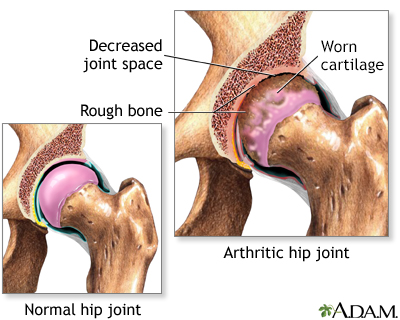
Click a word on the left and the definition will appear here:
Collagen: A protein that makes up the white fibers of connective tissue, such as cartilage.
Click a word on the left and the definition will appear here:
Corticosteroid: Medications (e.g., prednisone) that are related to cortisone, a naturally occurring hormone. Corticosteroids lessen inflammation, swelling, and pain. In some cases, corticosteroids are injected directly into a joint; however, they can have serious side effects -- such as damage to bones and cartilage -- especially when used over long periods of time.
Click a word on the left and the definition will appear here:
COX-2 inhibitors: A class of medications that were developed to manage the symptoms of arthritis without negative gastrointestinal effects of COX-1 inhibition. COX-2 inhibitors stop the activity of specific cyclooxygenase ("COX") enzymes, which release the substances (prostaglandins) responsible for pain and inflammation. A growing body of evidence suggests that COX-2 inhibitors carry heart risks that are real and important to consider, making it wise to weigh the risks versus the benefits when taking these NSAIDs, especially for someone who is at risk for cardiovascular disease. COX-2 inhibitors may elevate cardiovascular risks at any dose.
Click a word on the left and the definition will appear here:
Dimethyl sulfoxide (DMSO): Solvent (liquid capable of dissolving things) that easily penetrates the skin. It is a dangerous, unproven "remedy" for the pain and inflammation of arthritic disorders.
Click a word on the left and the definition will appear here:
Fibromyalgia: Disorder (also known as fibromyositis or tension myalgia) that primarily affects muscles and their attachments to bone. It does not cause joint deformity. Fibromyalgia is characterized by general muscle pain, stiffness, fatigue, sleeplessness, and numerous tender points at the sites where muscles join to bones.
Click a word on the left and the definition will appear here:
Genes: Biologic units of heredity that are located at a specific position on a particular chromosome (cell structure composed of a linear thread of genetic material).
Click a word on the left and the definition will appear here:
Gout: A disorder that is characterized by a variable level of uric acid (a normal byproduct of foods) in the blood and sudden severe arthritis due to crystal deposits (sodium urate) within the joints.
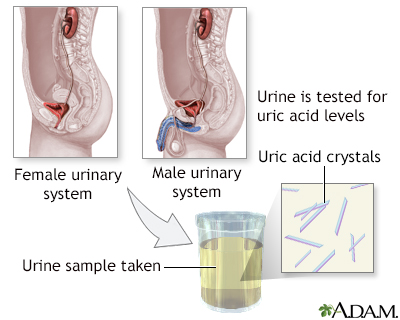
Click a word on the left and the definition will appear here:
H2-blockers: Chemicals that block the activity of histamine, which is a powerful stimulator of gastric acid production. Cimetidine (Tagamet), famotidine (Pepcid), and ranitidine (Zantac) are well-known H2-blockers.
Click a word on the left and the definition will appear here:
Heberden's nodes: Bony spurs that occur on the end joints of the fingers.
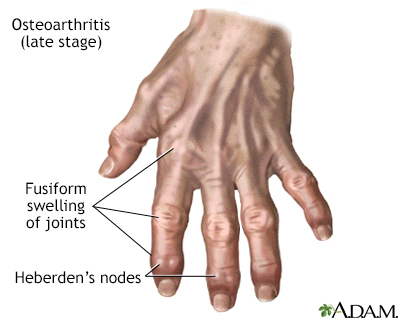
Click a word on the left and the definition will appear here:
Human leukocyte antigens (e.g., HLA-DR4 and HLA-DR1): Tissue-specific 'marker' proteins (HLA proteins) that are found on the surface of some cells, such as leukocytes (white blood cells). These proteins correspond to the HLA genes that are located on chromosome 6 in humans.
Click a word on the left and the definition will appear here:
Hyaluronic acid: Lubricating substance that is found in the normal joint fluid. Injectable hyaluronic acid -- which currently is marketed under the brand names Hyalgan and Orthovisc -- is an FDA-approved treatment for osteoarthritis of the knee.
Click a word on the left and the definition will appear here:
Joint replacement: Complete surgical removal of a painful joint, which then is exchanged for a man-made appliance.

Click a word on the left and the definition will appear here:
Nonsteroidal anti-inflammatory drugs (NSAIDs): Medications that are often used to relieve the symptoms of osteoarthritis. NSAIDs reduce the pain and swelling associated with inflammation. The most commonly used NSAIDs are aspirin, ibuprofen, and naproxen.
Click a word on the left and the definition will appear here:
Osteoporosis: Disorder in which bones and skeletal tissues become less dense and break easily. Osteoporosis occurs most often in post-menopausal women and elderly men.
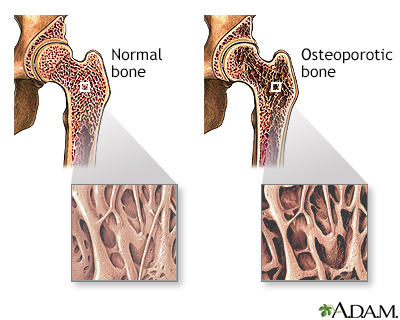
Click a word on the left and the definition will appear here:
Osteotomy: The cutting of a bone. More specifically, an operation in which the surgeon divides the bone below the affected joint and allows it to heal in a slightly altered position. The bone is realigned, with improved contact between the remaining healthy areas of cartilage in the joint.
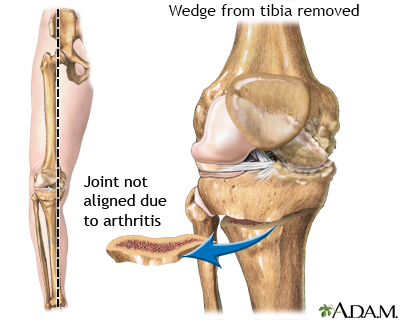
Click a word on the left and the definition will appear here:
Placebo: A medically inactive substance that is used in controlled studies to determine the effectiveness of a test drug. Placebos have been shown to lessen symptoms in some people, most likely because of the individual's positive attitude about treatment.
Click a word on the left and the definition will appear here:
Prostaglandin analog: Chemical that functions like a prostaglandin -- any of a group of fatty acid substances that perform a variety of functions within the body, including control of inflammation and blood vessel permeability and regulation of hormones, stomach acid secretion, body temperature, and smooth muscle contraction (for example, misoprostol [Arthrotec]).
Click a word on the left and the definition will appear here:
Proton-pump inhibitors: Chemicals that suppress stomach acid secretion by inhibiting a specific enzyme system on the surface of the stomach's parietal cells. This enzyme system is regarded as the acid (proton) pump within the stomach mucosa. Examples include esomeprazole (Nexium), lansoprazole (Prevacid), omeprazole (Prilosec, Zegerid), pantoprazole (Protonix), and and rabeprazole (Aciphex).
Click a word on the left and the definition will appear here:
Rheumatoid arthritis (RA): Disorder that is believed to result from an "autoimmune" process in which the body's immune system attacks itself. It is a system-wide disease that usually last for many years. In some patients, RA affects such organs as the heart, lungs, and eyes. Patients with active RA often feel feverish or ill.
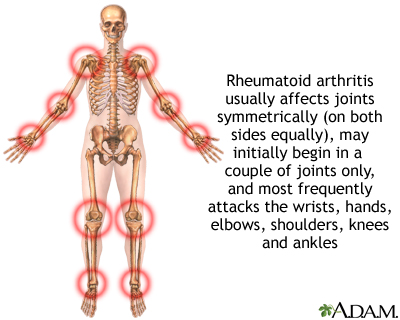
Click a word on the left and the definition will appear here:
Rheumatoid factor (RF): An antibody found in the blood of most people with rheumatoid arthritis.
Click a word on the left and the definition will appear here:
Spurs: Osteoarthritic condition in which bony growths project outward from the ends of a bone in a joint.

Click a word on the left and the definition will appear here:
Synovial fluid: Thick, clear fluid produced by the synovial membrane and found in joint cavities.

Click a word on the left and the definition will appear here:
Synovial membrane: Inner, smooth lining of the joint cavity.
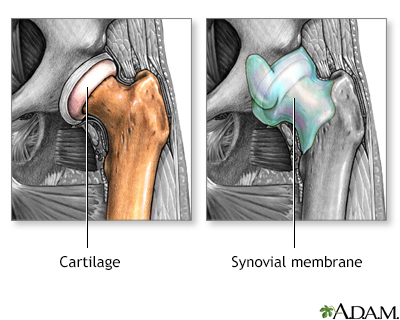
Click a word on the left and the definition will appear here:
Systemic lupus erythematosus (SLE): Inflammatory connective tissue disorder with variable features, including fever, fatigue, arthritis and joint pain, and red skin lesions on the face, neck, or upper limbs.
Click a word on the left and the definition will appear here:
Transcutaneous electrical nerve stimulation (TENS): Technique that directs small pulses of electricity to specific nerves. The aim is to reduce the sensitivity of nerve endings in the spinal cord, thereby closing the pain "gates."

|
Review Date:
12/24/2012 Reviewed By: Ariel D. Teitel, MD, MBA, Clinical Associate Professor of Medicine, Division of Rheumatology, NYU Langone Medical Center. Review provided by VeriMed Healthcare Network. |

